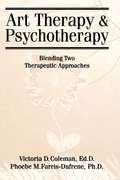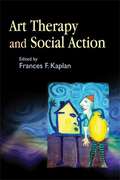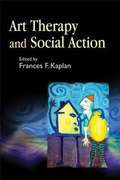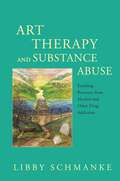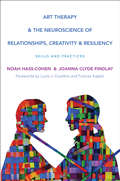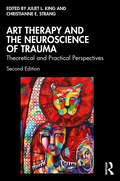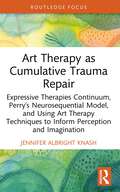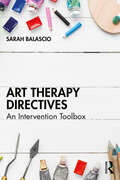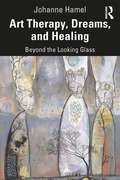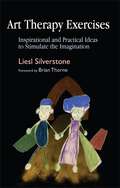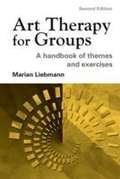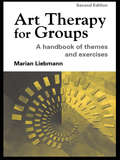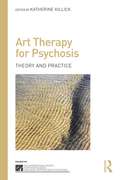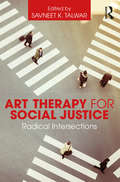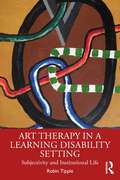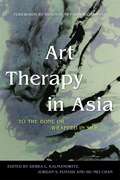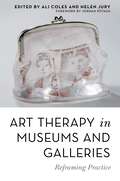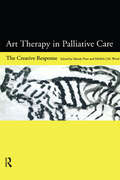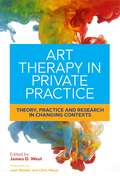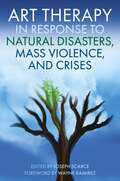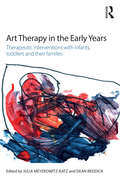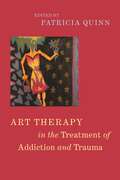- Table View
- List View
Art Therapy And Psychotherapy: Blending Two Therapeutic Approaches
by Victoria D. Coleman Phoebe Farris-DufreneFirst published in 1996. Routledge is an imprint of Taylor & Francis, an informa company.
Art Therapy and Social Action: Treating the World's Wounds
by Maxine Borowsky Junge Frances Kaplan Edward Ned Bear Pat Allen Susan BerkowitzArt Therapy and Social Action is an exciting exploration of how professionals can incorporate the techniques and approaches of art therapy in their work to address social problems. Examining the expanding role of art practitioner as social activist, leading art therapists and other professionals show how creative methods can be used effectively to resolve conflicts, manage aggression, heal trauma and build communities. The contributors provide examples of innovative programs on a range of topics, including those designed to address gun crime, homelessness, racism and experiences of terrorism, among others. This timely book provides new techniques and successful models for art therapists, counselors and mental health practitioners working directly with the challenges of modern society.
Art Therapy and Social Action
by Frances F. Kaplan Pat Allen Edward Ned Bear Susan Berkowitz Michael Franklin Lani Alaine Gerity David GussakArt Therapy and Social Action is an exciting exploration of how professionals can incorporate the techniques and approaches of art therapy in their work to address social problems. Examining the expanding role of art practitioner as social activist, leading art therapists and other professionals show how creative methods can be used effectively to resolve conflicts, manage aggression, heal trauma and build communities. The contributors provide examples of innovative programs on a range of topics, including those designed to address gun crime, homelessness, racism and experiences of terrorism, among others. This timely book provides new techniques and successful models for art therapists, counselors and mental health practitioners working directly with the challenges of modern society.
Art Therapy and Substance Abuse
by Libby SchmankeThis book provides art therapists with specific information on substance abuse treatment approaches and explains the bio-psycho-social aspects of addiction. By providing insight into the unique challenges of this client group, it gives art therapists the knowledge and confidence to develop effective interventions for individuals with addictions.
Art Therapy and the Neuroscience of Relationships, Creativity, and Resiliency: Skills and Practices
by Louis Cozolino Noah Hass-Cohen Joanna Clyde Findlay Frances KaplanPresenting a neuroscientifically aware approach to art therapy. Art Therapy and the Neuroscience of Relationships, Creativity, and Resiliency offers a comprehensive integration of art therapy and interpersonal neurobiology. It showcases the Art Therapy Relational Neuroscience (ATR-N) theoretical and clinical approach, and demonstrates how it can be used to help clients with autobiographical memory, reflecting and creating, touch and space, meaning-making, emotions, and dealing with long-term stress and trauma. The ATR-N approach, first developed by Noah Hass-Cohen, is comprised of six principles: Creative Embodiment, Relational Resonating, Expressive Communicating, Adaptive Responding, Transformative Integrating, and Empathizing and Compassion (CREATE). The chapters in this book are organized around these CREATE principles, demonstrating the dynamic interplay of brain and bodily systems during art therapy. Each chapter begins with an overview of one CREATE principle, which is then richly illustrated with therapeutic artwork and intrapersonal reflections. The subsequent discussion of the related relational neuroscience elucidates how the ATR-N work is grounded in research and evidence-based theory. The last section of each chapter, which is devoted to clinical skills and applications, integrates practices and approaches across all six of the CREATE principles, demonstrating how therapeutic art making can help people decipher the functional mystery of their relational nervous system, enhance their emotive and cognitive abilities, and increase the motivation to learn novel concepts and participate in a meaningful social discourse.
Art Therapy and the Neuroscience of Trauma: Theoretical and Practical Perspectives
by Juliet L. King Christianne E. StrangArt Therapy and the Neuroscience of Trauma, 2nd edition, lays out a unified framework of neural plasticity and resilience and places it within a broader social context. Using a lens grounded in multicultural humility, renowned figures in art therapy have updated chapters with content that takes a systematic yet inclusive approach. New chapters and new authors offer stimulating insights into individual and community factors that drive comprehensive care.This revitalized second edition offers an accessible and comprehensive text intended for novice and sage art therapists and students. The book also fosters a vision and a translational pathway for research that explores the protective factors of resilience and the universal impacts of psychological trauma with the systematic integration of art therapy and neuroscience.
Art Therapy as Cumulative Trauma Repair: Expressive Therapies Continuum, Perry’s Neurosequential Model, and Using Art Therapy Techniques to Inform Perception and Imagination (Advances in Mental Health Research)
by Jennifer Albright KnashThis book explores the effectiveness of art therapy as treatment for cumulative trauma survivors.Bringing together case studies, research, and the author’s clinical and personal experience, it outlines different clinical approaches as well as numerous art therapy interventions that are processed through somatic, metaverbal, and narrative means. It further aims to answer the question of “how art therapy works,” by pairing aspects of Lusebrink’s Expressive Therapies Continuum with Perry’s four functional domains (from the Neurosequential Model of Therapeutics) to demonstrate how these practices may increase relational capacity and the patient’s access to higher level functioning, in turn, decreasing trauma responses.Foregrounding a person-centered and multi-dimensional approach to trauma repair and creative interventions, this book will appeal to postgraduate students in art therapy and counselling, as well as professionals and researchers in somatic work and trauma specialties.
Art Therapy Directives: An Intervention Toolbox
by Sarah BalascioArt Therapy Directives: An Intervention Toolbox is an all-inclusive manual of art therapy directives designed to be a comprehensive and organized resource for art therapists and other trained mental health professionals. Art therapy directives are directions for creating art and often require use of specific art media, both of which are tailored to the client’s particular need. Using this book, art therapists will be able to search by population, themes, and art media to find just the right project for their session whether working with individuals or in groups. Comprised of a compilation from traditional art therapy directives, the author’s own experiences, and other published practices, a wide range of mental health topics are included such as depression, self-esteem, life transitions, and trauma. Special consideration is given to populations like adolescents, older adults, veterans, and the LGBTQ+ community. This manual is the answer that many in the field of art therapy have been missing for an all-encompassing, organized reference book to guide art therapy sessions with a wide variety of client populations..
Art Therapy, Dreams, and Healing: Beyond the Looking Glass
by Johanne HamelArt Therapy, Dreams, and Healing: Beyond the Looking Glass synthesizes methods to work with one’s dreams through art therapy and introduces the reader to brief creative methods, Gestalt and Jungian experiential methods, and research on lucid dreaming and dream re-entry. The author provides a unique, clear and concise synthesis of 19 available dreamwork methods to find the message of your dreams, with examples from her own 35 years of psychotherapy practice. Along with a classification of types and functions of dreams, chapters include information such as how to keep a dream journal, how to remember one’s dreams, how to identify 25 different dream types and how to follow your own dreamwork process. This book provides a succinct blend of available dreamwork methods for readers to find the existential message of their dreams and grow from them.
Art Therapy Exercises: Inspirational and Practical Ideas to Stimulate the Imagination
by Liesl Silverstone Brian ThorneThis accessible book comprises a collection of 80 tried-and-tested exercises, with guidelines for applying them and advice for devising new ones. Liesl Silverstone offers a variety of exercises for a diverse and multicultural client base, such as guided fantasies, one-to-one and group work focusing on the group dynamic, and some examples of working with adults with learning difficulties and children. Focusing on the non-directive, non-interpretive person-centred approach to art therapy, this inspirational book is the perfect complement to Art Therapy - The Person-Centred Way, also by Liesl Silverstone and published by Jessica Kingsley Publishers. Art Therapy Exercises is an invaluable book for art therapists and art therapy students, counsellors, psychotherapists and all professionals working in the field of human development.
Art Therapy for Groups: A Handbook of Themes and Exercises
by Marian LiebmannNew material on race, culture and diversity, A chapter on recording, evaluation and evidence-based practice, A survey of literature on art therapy group Seventy new themes An updated international resources section.
Art Therapy for Groups: A Handbook of Themes and Exercises
by Marian LiebmannFirst published in 2004. Routledge is an imprint of Taylor & Francis, an informa company.
Art Therapy for Psychosis: Theory and Practice (The International Society for Psychological and Social Approaches to Psychosis Book Series)
by Katherine KillickArt Therapy for Psychosis presents innovative theoretical and clinical approaches to psychosis that have developed in the work of expert clinicians from around the world. It draws on insights that have emerged from decades of clinical practice to explain why and how specialised forms of art therapy constitute a particularly appropriate psychotherapeutic approach to psychosis. The contributors present a diverse range of current theoretical perspectives on the subject, derived from the fields of neuroscience, phenomenology and cognitive analytic theory, as well as from different schools of psychoanalysis. Collectively, they offer insights into the specific potentials of art therapy as a psychotherapeutic approach to psychosis, and describe some of the specialised approaches developed with individuals and with groups over the past 20 years. Throughout the book, the meaning and relevance of art-making as a medium for holding and containing unbearable, unthinkable and unspeakable experiences within the psychotherapeutic setting becomes apparent. Several of the chapters present detailed illustrated case studies which show how making visual images with an appropriately trained art psychotherapist can be a first step on the path into meaningful relatedness. This book offers fresh insights into the nature of psychosis, the challenges encountered by clinicians attempting to work psychotherapeutically with people in psychotic states in different settings, and the potentials of art therapy as an effective treatment approach. It will be essential reading for mental health professionals who work with psychosis, including psychiatrists, psychoanalysts, psychotherapists and arts therapists, and those in training. Full colour versions of the illustrations can be viewed at http://isps.org/index.php/publications/book-series/publication-photos Please see p. ix of the book for details of how to access them.
Art Therapy for Social Justice: Radical Intersections
by Savneet K. TalwarArt Therapy for Social Justice seeks to open a conversation about the cultural turn in art therapy to explore the critical intersection of social change and social justice. By moving the practice of art therapy beyond standard individualized treatment models, the authors promote scholarship and dialogue that opens boundaries; they envision cross disciplinary approaches with a focus on intersectionality through the lens of black feminism, womanism, antiracism, queer theory, disability studies, and cultural theory. In particular, specific programs are highlighted that re-conceptualize art therapy practice away from a focus on pathology towards "models of caring" based on concepts of self-care, radical caring, hospitality, and restorative practice methodologies. Each chapter takes a unique perspective on the concept of "care" that is invested in wellbeing. The authors push the boundaries of what constitutes art in art therapy, re-conceptualizing notions of care and wellbeing as an ongoing process, emphasizing the importance of self-reflexivity, and reconsidering the power of language and art in trauma narratives.
Art Therapy in a Learning Disability Setting: Subjectivity and Institutional Life
by Robin TippleThis book originates from the experience of providing Art Therapy for adults diagnosed with learning disabilities living in an institutional setting. It follows two longitudinal case studies in an attempt to understand dyadic relations in Art Therapy. Representing an important contribution to the history of Art Therapy, especially as it relates to the history of learning disabilities, this book explores past and contemporary discourses and contexts to identify a meaningful, thoughtful approach to the making and reading of images and the client/therapist relationship. It presents the thinking that informed the author’s practice at the time, from both the point of view of the time and its present moment, to contextualize contemporary Art Therapy practice. Through the storytelling of long-term Art Therapy cases with thoughtful investigation, the author explores themes of melancholia, abjection, and alienation, while also creating a depth to current practice. The chapters are richly illustrated, the two case studies are personal and compelling, and the writing is accessible to all readers. The book will appeal to practicing and training therapists of all persuasions, but especially those in Art Therapy or learning disability fields that have an interest in the visual forms of imagining and communicating.
Art Therapy in Museums and Galleries: Reframing Practice
by Mary Chamberlain Michael Fischer Simon Hackett Bobby Lloyd Sue Holttum Nana Zhvitiashvili Emma Hollamby Elaine Homer Jane Landes Ruth McGovern Fiona Fitzpatrick Stephen Legari Marilyn Lajeunesse Louise Giroux Sheila Grandison Karen Lund Whittaker Scott Miriam Usiskin Naomi Press Andrée SalomThis is the first book to explore and evaluate the potential of museum and gallery spaces and partnerships for art therapy. Showcasing approaches by well-known art therapists, the edited collection contains descriptions of, and reflections on, art therapy in museums and galleries around the globe. Case studies encompass a broad range of client groups, including people with dementia, refugees and clients recovering from substance abuse, exploring the therapeutic skills required to work in these settings. The collection also establishes the context for art therapy in museums and galleries through reviewing key literature and engaging with the latest research, to consider wider perspectives on how these spaces inform therapeutic practice. Offering a comprehensive look at ways in which these locations enable novel and creative therapeutic work, this is an essential book for art therapists, arts and health practitioners and museum professionals.
Art Therapy in Palliative Care: The Creative Response
by Michele Wood Mandy PrattThis book provides a comprehensive and accessible introduction to the practice and results of art therapy in palliative care. It includes first-hand accounts from both therapists and clients in a variety of palliative care settings including:- * hospices and hospitals * patients own homes * prisons (AIDS patients) * adolescent griefwork groupsThese case studies include examples of client art work and illustrate clearly how art therapy can allow patients to regain feelings of control over their lives.
Art Therapy in Private Practice: Theory, Practice and Research in Changing Contexts
by James West Joan Woddis Chris Wood Julia Ryde Frances Walton Andrea Heath Catherine Stevens Hephzibah Kaplan Nili Sigal Stephen Radley Themis Kyriakidou Dave Rogers Kate Rothwell Colleen Steiner Westling David Edwards Anthea HendryAs perspectives on private art therapy practice evolve, this book provides an overview of the range of approaches, clinical settings, ethical issues and professional considerations when working outside of the formal structures of publically-funded services. An essential guide for art therapy students and experienced practitioners moving into private practice, it considers the impact of a private context on theory, practice and research. The book features contributions from art therapists with extensive experience in both private practice and public services and gives practical advice on potential difficulties, such as managing relationships with fee-paying clients, self-promotion and maintaining boundaries when practising from home.
Art Therapy in Response to Natural Disasters, Mass Violence, and Crises
by Amanda Sanders Maria Rollins Jill Charney Ronald Lay Elia Khalaf Alicia Ballestas Devora Weinapple Jess Linton Cynthia Wilson Geri Hurlbut Gaelynn P. Bordonaro Daniela Gloger Eduardo Torres Katrina Bobo Robin Valicenti Carla Van Laar Dr Maricel Ocasio-Figueroa Anais Lugo Axtmann Stephanie Wray Mercedes B. ter Maat Soraya Obeid Natacha Pirotte Laurence De Vandenborre Dianne Tennyson Vincent Barbara Naderi Leigh Ann Lichty Raquel Farrell-Kirk Jessica Asch Lisa Tricomi Bree Gordon Kelvin A. Ramirez Mitchell Kossak Joseph Mageary Maria Regina Alfonso Maria Johanna Ortiz-LuisWith contributions from a range of expert voices within the field, this book explores the use of art therapy as a response to traumatic events. Offering rare insight into ways in which art therapists have responded to recent crises, this is a unique resource for art therapists looking to coordinate interventions for large-scale disaster and resulting trauma. Chapters address a range of environmental and manmade disasters around the world, including hurricanes, typhoons, wildfires, mass shootings and forced migration, highlighting the impact of an art therapy approach in dealing with widespread trauma. Covering both community and individual cases, it provides an in-depth view into the challenges of working in these settings, including the effects on the therapist themselves, and offers practical information on how to coordinate, fund and maintain responses in these environments. The first book to focus on disaster response in art therapy, this will be an invaluable contribution to the field in an increasingly vital area.
Art Therapy in the Early Years: Therapeutic interventions with infants, toddlers and their families
by Julia Meyerowitz-Katz Dean ReddickArt therapy with infants, toddlers and their families is an exciting and developing area of practice. With contributions from Australia, the United Kingdom and Spain, Art Therapy in the Early Years has an international flavour. The authors describe clinical art psychotherapy practice with children under five and their families in settings that include children in care, mental health clinics, paediatric wards, pre-schools, and early intervention programs. Divided into three sections, Art Therapy in the Early Years presents different clinical environments in which art psychotherapy with this client group is found: • individual art therapy; • group art therapy; • parent-child dyad and family art therapy. The book proposes that within these different contexts, the adaptive possibilities inherent in art psychotherapy provide opportunities for therapeutic growth for young children and their families. Art Therapy in the Early Years will be of interest to art therapists working with children; students and practitioners from creative arts therapies; psychologists and psychotherapists; social workers; pre-school teachers; child psychiatrists, clinical supervisors, and other professionals working in the early years settings.
Art Therapy in the Treatment of Addiction and Trauma
by Peggy Kolodny Lauren Fabrizio Johanna Dobrich Linda Siegel Eileen McKee Lesley AtchitoffThis book examines the benefits and uses of art therapy in the treatment of addiction and trauma, highlighting its effectiveness at revealing underlying causes and relapse triggers, as well as treating co-occurring conditions that impair learning and recovery.This book also focuses on art therapy for trauma within specific populations, including incarcerated individuals, military personnel and survivors of commercial sexual exploitation. Quinn discusses how art therapy is often carried out alongside combined approaches, such as CBT and DBT, and how it can help those with cognitive issues to learn through treatment. Furthermore, this book explores the benefits art therapy has for people with co-morbid conditions, such as dementia, emotional disorders and traumatic and acquired brain injuries.With co-authored chapters from leading researchers in art therapy, the book demonstrates how art therapy can help to uncover triggers, process trauma and find a means of self-expression whilst working towards a sustained recovery.
Art Therapy Observation and Assessment in Clinical Practice: The ArTA Method
by Ingrid PénzesThis book describes ArTA, an evidence-based method for art therapy observation and assessment. This novel method argues the art-making process and art product are related to aspects of mental health. The results of the author’s own research show that observed patterns in material interaction, material experience, and the specific combinations of formal elements of the art product reveal the client’s balance between thinking and feeling, and adaptability. Divided into four sections, the book illustrates this research, theory, and application of the ArTA method using examples and case histories with clear frameworks that give guidance in art therapy observation and assessment. It provides direction for formulating treatment goals and drawing up appropriate treatment interventions. Intended for art therapy students and practicing art therapists, this methodology will challenge readers to rethink the relationship between a client’s interaction with art materials and their mental health.
Art Therapy Practices for Resilient Youth: A Strengths-Based Approach to At-Promise Children and Adolescents
by Marygrace Berberian Benjamin DavisArt Therapy Practices for Resilient Youth highlights the paradigm shift to treating children and adolescents as "at-promise" rather than "at-risk." By utilizing a strength-based model that moves in opposition to pathology, this volume presents a client-allied modality wherein youth are given the opportunity to express emotions that can be difficult to convey using words. Working internationally with diverse groups of young people grappling with various forms of trauma, 30 contributing therapists share their processes, informed by current understandings of neurobiology, attachment theory, and developmental psychology. In addition to guiding principles and real-world examples, also included are practical directives, strategies, and applications. Together, this compilation highlights the promise of healing through the creative arts in the face of oppression.
Art Therapy Research: A Practical Guide
by Donna Betts Sarah DeaverArt Therapy Research is a clear and intuitive guide for educators, students, and practitioners on the procedures for conducting art therapy research. Presented using a balanced view of paradigms that reflect the pluralism of art therapy research, this exciting new resource offers clarity while maintaining the complexity of research approaches and considering the various epistemologies and their associated methods. This text brings research to life through the inclusion of sample experientials in every chapter and student worksheets, as well as a full chapter on report writing that includes a completed sample report. This comprehensive guide is essential reading for educators looking to further the application of learning outcomes such as teamwork, communication, and critical thinking in their practice.
